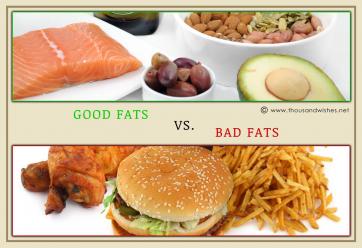 We need a certain amount of fat in our diets to stay healthy. Fats provide needed energy in the form of calories. Fats help our bodies absorb important vitamins—called fat-soluble vitamins—including vitamins A, D and E. Fats also make foods more flavorful and help us feel full. Fats are especially important for infants and toddlers, because dietary fat contributes to proper growth and development.
We need a certain amount of fat in our diets to stay healthy. Fats provide needed energy in the form of calories. Fats help our bodies absorb important vitamins—called fat-soluble vitamins—including vitamins A, D and E. Fats also make foods more flavorful and help us feel full. Fats are especially important for infants and toddlers, because dietary fat contributes to proper growth and development.
“Fats are really the most concentrated source of energy in the foods we eat, and our bodies need that energy,” says NIH nutritionist Dr. Margaret McDowell. “Fats are truly an essential nutrient.”
Problems arise, though, if we eat too much fat. Dietary fats have more than twice as many calories per gram as either proteins or carbohydrates like sugar and starch. Excess calories, of course, can pack on the pounds and raise your risk for diabetes, cancer and other conditions.
“Some fats are better for our bodies than others,” McDowell says. “We should really aim to eat the right types of fats.”
Unsaturated fats are considered “good” fats. They’re sometimes listed as “monounsaturated” and “polyunsaturated” fat on Nutrition Facts labels. These can promote health if eaten in the right amounts. They are generally liquid at room temperature, and are known as oils. You’ll find healthful unsaturated fats in fish, nuts and most vegetable oils, including canola, corn, olive and safflower oils.
The so-called “bad” fats are saturated fats and trans fats. They tend to be solid at room temperature. Solid fats include butter, meat fats, stick margarine, shortening, and coconut and palm oils. They’re often found in chocolates, baked goods, and deep-fried and processed foods.
“When we eat too many solid fats, we put our bodies at risk. These fats tend to raise total blood cholesterol, as well as the part of cholesterol known as low-density lipoprotein (LDL) cholesterol (bad cholesterol),” says McDowell. LDL can lead to the buildup of plaque in the arteries and cardiovascular problems.
Experts say that the total fat intake for adults ages 19 and older should be 20% to 35% of the calories eaten each day. For children ages 4 to 18, it should be 25% to 35%. Less that 10% of our fat calories should come from saturated fatty acids.
Other NIH-funded research found that, when it comes to weight loss, the source of calories—whether from fat, protein or carbohydrate—isn’t as important as the number of calories you consume. But when it comes to risk factors for heart disease, replacing some carbohydrates with protein or unsaturated fats can greatly improve blood cholesterol. In a specialized diet designed to lower blood pressure, using unsaturated fats in place of some carbohydrates boosted blood levels of “good” cholesterol (HDL cholesterol) and caused a more healthful drop in blood pressure.
Source: National Institutes of Health
